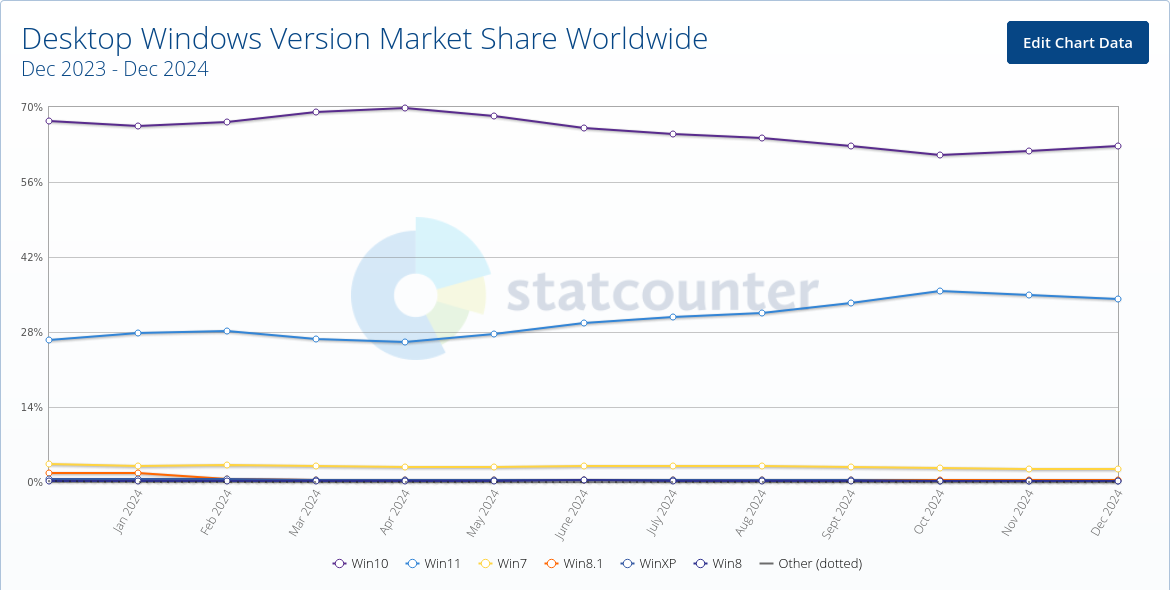
Over 60% of Windows machines in the world are still running on Windows 10 – which reaches end-of-support in just nine months as consumers and enterprise buyers alike kick the can on fleet overhauls.
With the default for those users after October 2025 being no more security updates from Microsoft, that could be a real issue if consumers and enterprises alike don't start taking action, experts have warned.
Windows 11 use has crept up from the 25% mark in early 2024 to the 35% mark by the end of the calendar year, according to data from Statcounter, but the figures are striking given the support deadline.
(“If you need more time before moving to a Copilot+ PC or other new Windows 11 device, a one-year Extended Security Updates (ESU) programme for $30 USD,” Microsoft emphasises to customers…)

Migrations for most have been largely smooth sailing, partners insist.
As Ian Stretton of Microsoft partner Infinity Group, told The Stack: “While ensuring hardware compatibility remains a priority, the process has been streamlined thanks to tools like Microsoft's Endpoint Manager, which helps identify devices that meet Windows 11 requirements…”
“In our experience, the deployment process itself is straightforward,” he added. “Windows Update for Business and Autopilot have significantly simplified the rollout, making it more efficient and less error-prone.
“Pilot testing and user training have further eased the transition, ensuring minimal disruption and a smoother user experience. Windows 11's enhanced security features have been a welcome addition, providing better protection against modern threats. Proper configuration and utilisation of these features have been key focuses during the migration.”
Windows 11, of course, has specific hardware requirements and OEMs continue to bet that a major refresh cycle is on its way, eventually…
“Consumer demand continues to be challenged [but] we are optimistic about the coming PC refresh cycle as the install base continues to age, and with Windows 10 reaching end-of-life” Dell CFO Jeff Clark said.
Drivers of an refresh include not just Windows 10 EOL but “AI workloads on the PC, which have higher memory requirements. There is also a large aging PC fleet which was bulk-purchased during COVID,” Todd Johnson, President of Avalon, a Dell Platinum partner, noted to CRN late last year.
Jonathan Dedman of application modernisation and migration specialist Cloudhouse, noted to The Stack: “Enterprises are likely to have a reliance on older long-standing applications that could be impossible to move to new Windows 11 environments, so getting early visibility of this is key to remove the risk of disruption. Some of these applications may be upgradable to work on Windows 11, so the cost and duration of an upgrade project needs to be calculated.
“For applications that need to be retained but cannot be upgraded, or upgraded before the end of support, there are options available,” he added, pointing to both up to three years of extended support for Windows 10 from Microsoft and the ability to move applications “unmodified onto a Windows 11 environment. These involve a project to make the application portable or to virtualise the application…”
To David Weston, Vice President, Enterprise and OS Security at Microsoft, moving comes with major security benefits: "Out-of-the-box features such as credential safeguards, malware shields, and application protection led to a reported 58% drop in security incidents, including a 3.1 times reduction in firmware attacks. In Windows 11, hardware and software work together to help shrink the attack surface, protect system integrity, and shield valuable data."
Sign up for The Stack
Interviews, Insight, Intelligence for Digital Leaders
No spam. Unsubscribe anytime.
